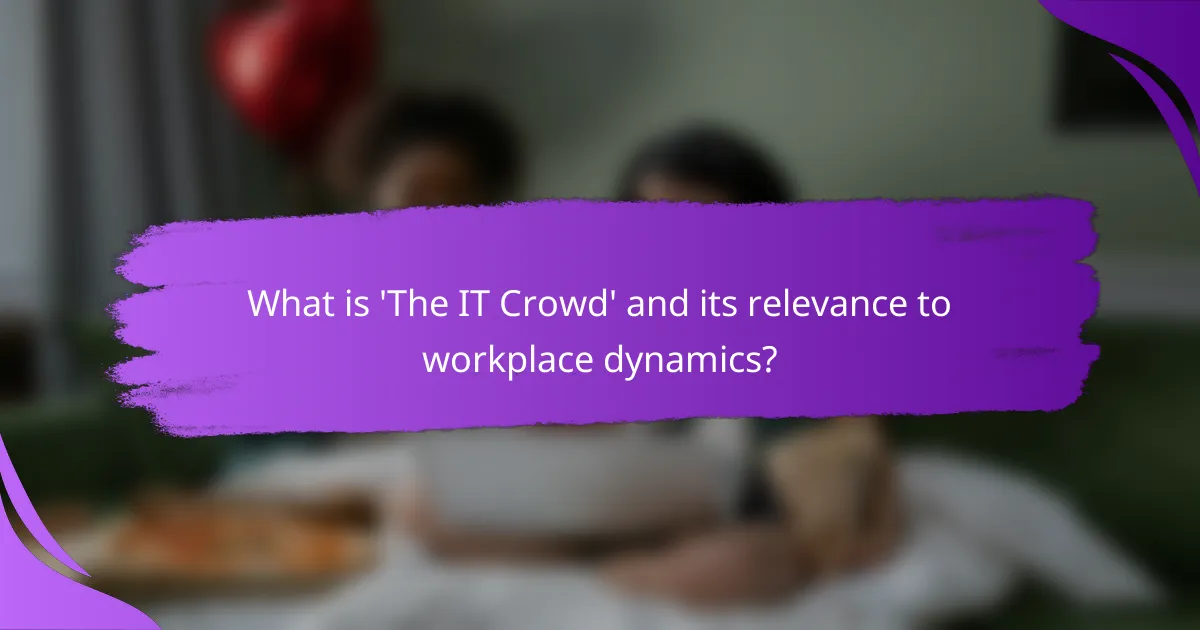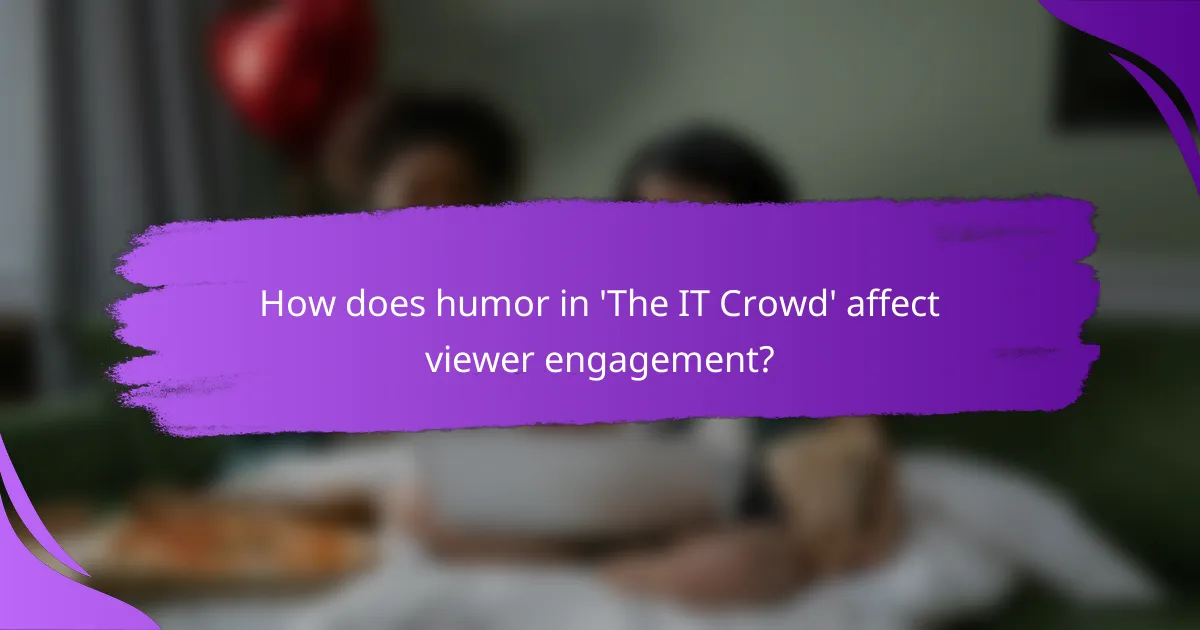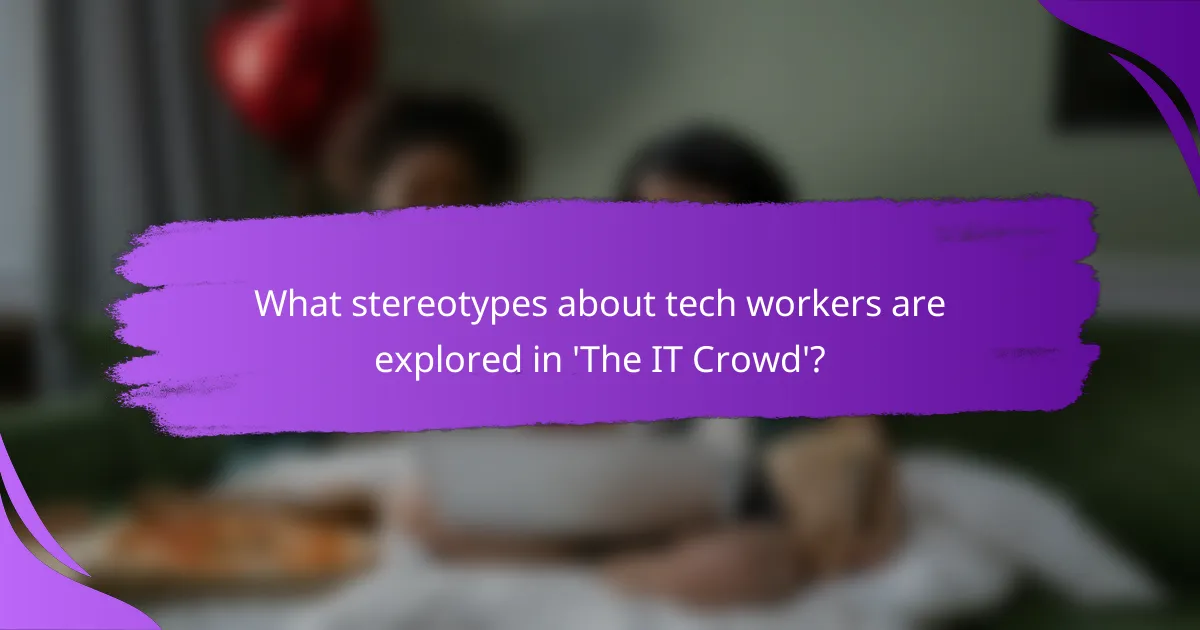‘The IT Crowd’ is a British sitcom that focuses on the IT department of a fictional corporation, highlighting the humorous interactions between socially awkward IT staff and their technologically challenged colleagues. The show effectively portrays common workplace dynamics, such as miscommunication and stereotypes about tech workers, through characters like Moss and Roy, who exemplify the challenges faced by IT professionals. The series uses humor to engage viewers, creating relatable scenarios that resonate with audiences in tech environments. It explores various stereotypes associated with tech workers, including social awkwardness and reliance on technology, while emphasizing the importance of understanding and collaboration across different departments in modern workplaces.

What is ‘The IT Crowd’ and its relevance to workplace dynamics?
‘The IT Crowd’ is a British sitcom centered around the IT department of a fictional corporation. It humorously portrays the interactions between socially awkward IT staff and their technologically challenged colleagues. The show highlights common workplace dynamics, such as miscommunication and stereotypes about tech workers. Characters like Moss and Roy exemplify the challenges faced by IT professionals in a corporate setting. Their experiences reflect real-life scenarios in many organizations. The series has become relevant for its comedic take on technology’s role in modern workplaces. It encourages viewers to consider the importance of understanding and collaboration across different departments.
How does ‘The IT Crowd’ portray the tech industry?
‘The IT Crowd’ portrays the tech industry as a realm dominated by quirky, socially awkward individuals. The show highlights stereotypes such as the incompetent management and the disconnect between tech support and end-users. Characters like Moss and Roy exemplify the typical IT workers, showcasing their technical skills alongside their lack of social graces. The humor often arises from misunderstandings and the absurdity of tech-related situations. For example, the infamous “Have you tried turning it off and on again?” line emphasizes the simplistic solutions often sought in complex tech issues. Overall, the series presents a comedic yet critical view of the tech industry’s culture and dynamics.
What are the main themes presented in ‘The IT Crowd’?
The main themes presented in ‘The IT Crowd’ include workplace dynamics, humor, and technology stereotypes. Workplace dynamics are explored through the interactions between the IT department and other employees. The show highlights the disconnect between tech workers and non-tech staff. Humor is a significant element, often derived from the absurdity of situations and character quirks. Technology stereotypes are addressed, portraying IT professionals as socially awkward and misunderstood. These themes combine to create a comedic yet insightful commentary on modern office culture.
How do the characters represent typical workplace roles in tech?
The characters in ‘The IT Crowd’ represent typical workplace roles in tech by embodying distinct archetypes. Moss represents the quirky, socially awkward tech genius. He showcases advanced technical skills but struggles with interpersonal communication. Roy illustrates the disillusioned IT support worker. He often displays frustration with users and the mundane aspects of tech support. Jen serves as the non-technical manager, highlighting the disconnect between management and technical staff. Her character demonstrates the challenges of leading a team without a technical background. Collectively, these characters reflect common stereotypes in tech workplaces, such as the introverted coder, the frustrated support staff, and the out-of-touch manager. This representation reinforces the humorous yet relatable dynamics often found in real tech environments.
What impact does ‘The IT Crowd’ have on perceptions of workplace dynamics?
‘The IT Crowd’ significantly influences perceptions of workplace dynamics by humorously portraying IT professionals and office culture. The show highlights stereotypes, such as the socially awkward tech worker, which can shape audience views on real-life IT roles. It depicts a chaotic office environment, emphasizing the disconnect between departments. This portrayal may lead viewers to see workplace interactions as more comedic and less serious. The series also illustrates the importance of camaraderie among coworkers, even in dysfunctional settings. Such representations can affect how employees perceive their own workplace relationships. Overall, ‘The IT Crowd’ impacts societal views on tech roles and workplace interactions through its comedic lens.
How does humor influence workplace relationships as depicted in the show?
Humor significantly enhances workplace relationships in “The IT Crowd.” It fosters camaraderie among characters, such as Roy, Moss, and Jen. Their shared jokes create a sense of belonging. Humor also diffuses tension during stressful situations. For example, the characters often use sarcasm to navigate office challenges. This approach promotes a relaxed atmosphere. As a result, employees feel more comfortable expressing themselves. The show illustrates that humor can bridge gaps between different personalities. Ultimately, humor strengthens team dynamics and improves collaboration.
What stereotypes about tech workers are addressed in ‘The IT Crowd’?
‘The IT Crowd’ addresses several stereotypes about tech workers. It portrays them as socially awkward individuals. The characters often struggle with interpersonal communication. This reflects the stereotype that tech workers lack social skills. The show also depicts tech workers as being overly obsessed with technology. Characters frequently display a lack of interest in non-technical subjects. Additionally, the series highlights the stereotype of tech workers being out of touch with reality. They often rely on stereotypes to interact with others. These portrayals contribute to a humorous yet critical view of the tech industry.

How does humor in ‘The IT Crowd’ affect viewer engagement?
Humor in ‘The IT Crowd’ significantly enhances viewer engagement. The show’s comedic elements create relatable scenarios for audiences, particularly in tech environments. Characters often find themselves in absurd situations that resonate with viewers’ own experiences. This relatability fosters a connection between the audience and the characters. Additionally, the use of witty dialogue keeps viewers entertained and encourages them to keep watching. Research indicates that humor can increase memory retention of content, making it more memorable for viewers. The show’s unique blend of humor and tech stereotypes effectively captures audience attention, leading to sustained interest in the series.
What types of humor are prevalent in ‘The IT Crowd’?
The prevalent types of humor in ‘The IT Crowd’ include absurdist humor, situational comedy, and character-driven humor. Absurdist humor is evident in the show’s surreal scenarios, such as the iconic “Have you tried turning it off and on again?” line. Situational comedy arises from the awkward interactions among the socially inept characters and their mundane office environment. Character-driven humor focuses on the distinct personalities of the main characters, like Moss’s eccentricities and Roy’s cynicism, creating comedic moments through their interactions. These humor types effectively highlight tech stereotypes and workplace dynamics, making the show relatable to its audience.
How does situational comedy enhance the storytelling?
Situational comedy enhances storytelling by providing humor that drives character development and plot progression. It creates relatable scenarios that reflect real-life experiences. This relatability allows audiences to connect emotionally with the characters. Humor in situational comedy often highlights the absurdities of everyday life, making the narrative more engaging. In “The IT Crowd,” comedic elements reveal the quirks of workplace dynamics in the tech industry. The show’s humor breaks tension and fosters camaraderie among characters. This dynamic enriches the storytelling by balancing serious themes with lighthearted moments. Ultimately, situational comedy serves as a vehicle for deeper themes, making the narrative more impactful.
What role does character-driven humor play in the series?
Character-driven humor plays a crucial role in ‘The IT Crowd’ by enhancing character development and audience engagement. This type of humor is rooted in the personalities and quirks of the main characters. It allows viewers to connect with the characters on a deeper level. For example, Moss’s awkwardness and Roy’s cynicism create comedic situations that reflect their unique traits. This humor also serves to highlight workplace dynamics, showcasing the absurdities of office life in a tech environment. The show’s use of character-driven humor helps to break stereotypes associated with tech professionals. By portraying characters in humorous situations, the series challenges preconceived notions about their social skills and personalities. Overall, character-driven humor is a key element that enriches the narrative and resonates with the audience.
Why is humor important in workplace settings according to ‘The IT Crowd’?
Humor is important in workplace settings according to ‘The IT Crowd’ because it fosters camaraderie among employees. The show illustrates how humor can alleviate stress in high-pressure environments. It also highlights that humor helps break down hierarchical barriers. Characters often use jokes to connect with colleagues and create a more relaxed atmosphere. This dynamic encourages open communication and collaboration. Studies show that workplaces with humor have higher employee satisfaction. Humor can also enhance creativity by promoting a positive mindset. Overall, ‘The IT Crowd’ demonstrates that humor is a vital tool for improving workplace dynamics.
How does humor contribute to stress relief in a tech environment?
Humor contributes to stress relief in a tech environment by promoting relaxation and enhancing team cohesion. Laughter triggers the release of endorphins, which are natural mood lifters. This physiological response reduces feelings of anxiety and tension. In tech settings, humor can break down hierarchical barriers, fostering open communication among team members. A study by the University of Maryland found that humor can significantly improve workplace morale. Additionally, shared laughter creates bonds that enhance collaboration and productivity. This is particularly important in high-pressure tech environments where stress levels can be elevated. Therefore, incorporating humor into daily interactions can lead to a more positive and productive workplace atmosphere.
What lessons can be learned about humor in professional interactions?
Humor in professional interactions can enhance relationships and improve communication. It fosters a positive work environment and encourages collaboration among team members. Research by Robert Provine indicates that laughter can strengthen social bonds and create a sense of belonging. Additionally, appropriate humor can diffuse tension during stressful situations, making it easier to navigate conflicts. However, it is crucial to understand the context and audience when using humor. Misplaced humor can lead to misunderstandings or offend colleagues. Therefore, using humor effectively requires awareness of workplace dynamics and cultural sensitivities.

What stereotypes about tech workers are explored in ‘The IT Crowd’?
‘The IT Crowd’ explores several stereotypes about tech workers. One prominent stereotype is that tech workers are socially awkward. This is illustrated through the character of Moss, who often struggles with social interactions. Another stereotype is the depiction of tech workers as being obsessed with technology. This is shown through the characters’ extreme reliance on gadgets and computer systems. The show also portrays tech workers as lacking in traditional workplace skills. For instance, the characters often fail to communicate effectively with non-technical staff. Additionally, the series highlights the stereotype of tech workers as being unkempt or disheveled. This is evident in the casual attire and appearance of the main characters. Overall, ‘The IT Crowd’ uses humor to exaggerate these stereotypes for comedic effect.
How does ‘The IT Crowd’ challenge common tech stereotypes?
‘The IT Crowd’ challenges common tech stereotypes by portraying tech professionals in diverse and humorous ways. The show features characters who break the mold of the socially awkward nerd. For example, the character Moss is portrayed as quirky yet competent, showcasing intelligence without the typical social ineptitude. Additionally, the character Jen defies stereotypes by being a capable manager in a tech environment, despite lacking technical skills. This representation highlights that tech roles can be filled by individuals with varied personalities and backgrounds. The humor in the show often stems from the absurdity of workplace situations rather than typical tech-related tropes. Overall, ‘The IT Crowd’ effectively uses comedy to subvert expectations and broaden the narrative around tech professionals.
What unique attributes do the characters possess that defy stereotypes?
The characters in ‘The IT Crowd’ possess unique attributes that defy common stereotypes. For instance, Moss is highly intelligent but socially awkward, challenging the stereotype of the socially inept techie. Roy, on the other hand, displays a laid-back attitude and a desire for social interaction, countering the image of the introverted programmer. Jen, as a manager with no technical background, breaks the stereotype of tech roles being exclusively filled by men. Each character showcases depth and complexity, illustrating that individuals in tech can have varied personalities and interests. This diversity in character traits enhances the humor and relatability of the show, making it resonate with a broader audience.
How does the show portray the diversity within the tech industry?
The show portrays diversity within the tech industry through its varied character backgrounds. It features characters from different ethnicities, genders, and social classes. For instance, the character of Jen is a woman in a male-dominated environment. She represents female presence in tech roles, highlighting gender diversity. Additionally, the show includes characters like Moss, who is portrayed as socially awkward yet highly skilled. This reflects the diversity of personalities within the industry. Furthermore, the series satirizes stereotypes, showing that talent exists across different demographics. The diverse representation aims to challenge traditional tech industry norms. Overall, the show uses humor to address and normalize diversity in tech.
What are the implications of these stereotypes on workplace culture?
Stereotypes in the workplace can create a negative culture. They often lead to discrimination and bias against certain groups. This can result in decreased employee morale and engagement. When employees feel marginalized, their productivity may decline. Stereotypes can also hinder collaboration and communication among team members. A lack of diversity in perspectives can stifle creativity and innovation. Furthermore, these stereotypes can reinforce power imbalances within the organization. Ultimately, a culture influenced by stereotypes can lead to high turnover rates and difficulty attracting talent. Studies show that diverse teams outperform homogeneous ones, highlighting the importance of an inclusive workplace culture.
How can understanding stereotypes improve team dynamics?
Understanding stereotypes can improve team dynamics by fostering awareness and reducing biases. When team members recognize common stereotypes, they can challenge assumptions about each other. This leads to more open communication and collaboration. Enhanced understanding promotes empathy among team members. Empathy fosters a supportive environment that values diverse perspectives. Research shows that diverse teams outperform homogeneous ones in problem-solving. For example, a study by McKinsey found that companies with diverse teams are 35% more likely to have financial returns above their respective national industry medians. Thus, addressing stereotypes can enhance team performance and cohesion.
What strategies can workplaces adopt to counteract negative stereotypes?
Workplaces can adopt several strategies to counteract negative stereotypes. First, they can implement diversity training programs. These programs educate employees about biases and promote inclusivity. Second, organizations should encourage open dialogue about stereotypes. This fosters a culture of understanding and empathy. Third, showcasing diverse role models within the company can challenge existing stereotypes. Representation in leadership and visible roles is crucial. Fourth, workplaces can create policies that promote equity in hiring and promotions. This ensures that all employees have equal opportunities. Fifth, celebrating cultural events and diversity can enhance awareness. Engaging in community outreach further supports this effort. Research shows that diverse teams perform better and are more innovative. According to McKinsey, companies with more diverse workforces are 35% more likely to outperform their peers.
What practical insights can we gain from ‘The IT Crowd’ regarding workplace dynamics?
‘The IT Crowd’ provides practical insights into workplace dynamics by highlighting communication barriers and team collaboration. The show depicts how misunderstandings arise from technical jargon. This emphasizes the importance of clear communication in diverse teams. Additionally, it showcases the impact of stereotypes on employee roles. Characters often face preconceived notions based on their job titles. This illustrates how bias can affect workplace relationships and morale. The series also demonstrates the value of humor in alleviating stress. Humor can foster camaraderie among team members. Overall, ‘The IT Crowd’ reflects real-life challenges and solutions in workplace dynamics.
How can humor be effectively used to enhance workplace relationships?
Humor can enhance workplace relationships by fostering a positive environment. It encourages open communication among colleagues. Laughter can reduce stress and tension in the workplace. A study published in the Journal of Business and Psychology found that humor improves team cohesion. Humor can also break down hierarchical barriers, making interactions more approachable. It promotes creativity and innovation by encouraging risk-taking in ideas. Moreover, shared laughter strengthens bonds and builds trust among team members. This ultimately leads to improved collaboration and productivity.
What best practices can be taken from ‘The IT Crowd’ for modern workplaces?
‘The IT Crowd’ offers several best practices for modern workplaces. Emphasizing open communication improves team collaboration. Encouraging humor can reduce stress and enhance morale. Establishing a supportive environment fosters creativity and innovation. Recognizing individual strengths leads to better task allocation. Implementing a clear hierarchy helps in efficient decision-making. Promoting work-life balance contributes to employee satisfaction. Regular team-building activities strengthen relationships among colleagues. These practices can lead to a more productive and positive workplace atmosphere.
‘The IT Crowd’ is a British sitcom that explores workplace dynamics, humor, and tech stereotypes through the interactions of socially awkward IT staff and their non-technical colleagues. The show highlights common themes such as miscommunication and the portrayal of tech workers, using humor to address stereotypes and enhance viewer engagement. Key characters exemplify typical roles in the tech industry, showcasing the challenges faced by IT professionals and the importance of collaboration across departments. Ultimately, the series provides insights into the impact of humor on workplace relationships and offers best practices for improving team dynamics in modern work environments.